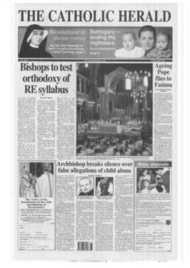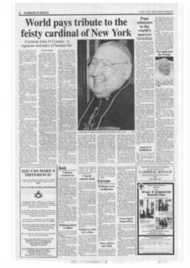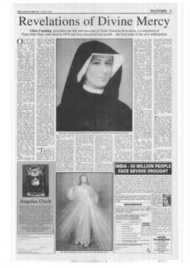Page 9, 12th May 2000
Page 9

Report an error
Noticed an error on this page?If you've noticed an error in this article please click here to report it.
Tags
Share
Related articles
Gospels' Openness To New Interpretations
Is This Really The Historical Jesus?
Lucy Lethbridge Talks To Geza Vermes About Jesus The Jew
One Scholar's View Of The Christianity Of Christ
Recovering The Jewish Identity Of Jesus Christ
Jesus through the Looking-glass
Dwight Longenecker watches a Jewish New Testament scholar select texts which support his arguments
The Changing Faces of Jesus by Geza Vermes, Allen Lane: The Penguin Press, £18.99
IN 1926 THE PROTESTANT scholar Rudolf Bultmann admitted, "1 do indeed think that we can now know almost nothing concerning the life and personality of Jesus". Bultmarinis pessimism has done nothing to stern the flow a books about the historical Jesus. Each author believes he can explain the eternal enigma ofJesus the Man, but too often each scholar's portrait of Jesus ends up looking more like the scholar than Jesus. This tendency to draw self portraits has caused a more recent scholar, John Dominic Crossan to remark, "It is impossible to avoid the suspicion that historical Jesus research is a very safe place to do theology and call it history or to do autobiography and call it biography".
One of the more fascinating writers in this field is Geza Vermes. Well known for his translation of the Dead Sea Scrolls, Vermes was born into a Hungarian Jewish family that had converted to Catholicism. The young Vermes was ordained as a Catholic priest, only to return to the faith of his fathers in the 1960s. 14e is now Professor Emeritus of Jewish Studies at Oxford, and has written a trilogy of books exploring the first century Jewish background of Jesus of Nazareth.
Crucial to his work has been his comparison of Jesus to two other charismatic Jewish teachers: Honi (first century BC) and the Galilean Hanina ben Dosa (first century AD). The Changing Faces of Jesus is Vermes's attempt to look behind the divine Christ developed by the Hellenistic church to glimpse Jesus the charismatic Jewish preacher. In order to do this. Verrnes ventures into the wonderland of New Testament scholarship.
The problem with this particular world is there are so many theories about authorship of particular books and crucial passages that one can salvage or jettison texts to prove almost any thesis. A phalanx of scholars can then be chosen to buttress your selection. Unfortunately, those with opposing views are busy assembling their own band of scholars and arguing just as persuasively for their particular texts.
A good example of this is the authorship of the Epistle to the Colossians. The balance is now in favour of Paul, with good justification. Vermes, however, claims that most scholars consider Colossians to have be written not by Paul himself but by his disciples and heirs. Colossians includes the famous passage in which Jesus is called the "image of the unseen God". If this is by Paul, then it does not fit Vermes's thesis that all ideas of a divine Christ are later Hellenistic concepts. One therefore cannot help suspecting that Vermes chooses those scholars who reject the Pauline authorship of Colossians since that better supports his view. A more blatant example of special pleading is Vermes's treatment of Philippians 2, where Paul says Jesus is "in very nature God". It is virtually universally accepted that St Paul, writing around the year 60, is quoting an even earlier Christian hymn. Venues simply asserts that "the hymn makes much better sense if it is taken as an existing liturgical composition inserted into the letter not by Paul himself, but by a later editor".
Vermes has said that he is simply trying to get beyond 2,000 years of Christian interpretation to understand how a sympathetic first century Jew would have responded to Jesus. He seems to forget that in the New Testament we have a document telling us
exactly how sympathetic first century Jews thought about Jesus. One of them called Peter thought Jesus was the "spotless lamb which existed from before the foundation of the world" (I Pt. 1:20) and another called Paul thought he was "the image of the unseen God" (Col. 1:13)
The underlying problem with Vermes's New Testament scholarship is the same as that of Protestantism. Neither of them accept an authentic interpretative authority for Scripture. Although they cannot stand one another.
the conservative Protestant and the liberal academic both cling to a kind of sola Scriptura, and that lack of an external authority means they both end up in the same quicksand of contradictory interpretations, all of which express not much more than the writer's personal opinion.
That said, Vermes is a genuine scholar. He writes well and his seminal work on both the Dead Sea Scrolls and the first century Jewish background to the gospels is indispensable. His charismatic Jewish teacher is not alien from the Jesus of the synoptic account, and his work sheds valuable light on Jesus the man. Indeed, in 1984, in its authoritative declaration on Christology, the Papal Biblical Commission said Vermes is one of those Jewish historians whose work must be accorded "serious attention by Christian theologians". Vermes's books on Jesus are important, and if his Jesus is taken with all the others, despite Buttmann's pessimism, a fascinating mosaic portrait of the human Jesus can be pieced together.
blog comments powered by Disqus













